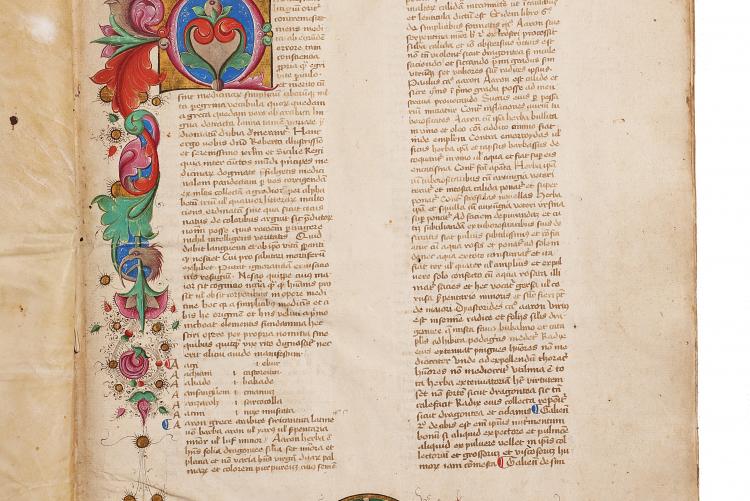Metà del sec. XV - Carta e pergamena, legatura in mezza pelle su cartone, 350x450 mm - Biblioteca diocesana Agnesiana, Vercelli
- Contiene l’intero Liber pandectarum medicinae, noto anche come Medicinalis pandecta, scritto da Matteo Silvatico, medico salernitano vissuto tra il 1280 e il 1342 e proprietario di un giardino in cui coltivava le piante medicinali. L’opera, terminata intorno al 1332 e dedicata a Roberto d’Angiò, re di Napoli dal 1309 al 1343, intende fornire la corretta denominazione dei “semplici” (oggi li chiamiamo “princìpi attivi”) di origine vegetale, minerale e animale. Ognuno dei circa 650 lemmi, in ordine alfabetico, è indicato con il nome arabo, greco e latino, cui fa seguito una precisa descrizione morfologica, le proprietà curative e alcune osservazioni personali o desunte da altri autori.
Il manoscritto vercellese è uno dei 18 finora individuati e uno dei 9 del sec. XV. L’opera di Matteo Silvatico ebbe poi numerose edizioni a stampa a partire dall’aprile 1474. - It comprises the whole Liber Pandectarum Medicinae, also known as Medicinalis Pandecta, written by Matthew Silvatico, a doctor from the Salerno area who lived between 1280 and 1342 who owned a garden where he cultivated medical herbs. This work, which was finished about 1332 and which was dedicated to Robert of Anjou, King of Naples from 1309 to 1343,was intended to provide the correct terms of the "Simple" ( today we call them active ingredients) of plant mineral or animal origin. Each of the roughly 650 terms in alphabetical order, is indicated with its Arab, Greek and Latin name. These are followed by a precise morphological description, its healing property and other observations, either personal or deduced by other writers
The Vercelli manuscript is one of the18 copies identified up to now and one of the 9 dating from the XV century. The work by Matthew Silvatico was printed many times after 1474. - Il contient l’entier Liber pandectarum medicinae, connu aussi comme Medicinalis pandecta, écrit par Mathieu Silvatico, médecin de Salerne vécu entre 1280 et 1342 et propriétaire d’un jardin où il cultivait des plantes médicinales. L’œuvre, terminée autour de 1332 et dédiée à Robert d’Anjou, roi de Naples de 1309 à 1343, entend donner la dénomination correcte des “simples” (aujourd’hui on les appelle “principes actifs”) d’origine végétale, minérale et animale. Chacun des environ 650 lemmes, en ordre alphabétique, est indiqué avec le nom arabe, grec et latin, suivis par une description morphologique précise, les propriétés curatives et quelques observations personnelles ou déduites d’autres auteurs.
Le manuscrit de Vercelli est un parmi les 18 identifiés à ce jour et un parmi les 9 du XV siècle. L’œuvre de Mathieu Silvatico eut plusieurs éditions imprimées à partir d’avril 1474.
